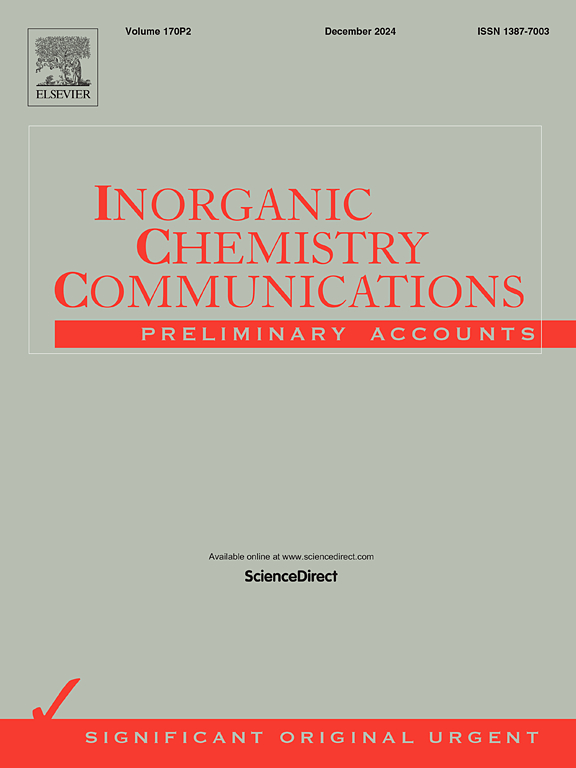H2O2-sensitive release of curcumin and zinc in normal and infected simulated cell tissues from a curcumin-zinc coordination complex with prolonged antibacterial activity
IF 4.4
3区 化学
Q1 CHEMISTRY, INORGANIC & NUCLEAR
引用次数: 0
Abstract
Concerns arising from the improper use of antibacterial chemicals, which has resulted in antibacterial resistance, environmental pollution, high costs, and so on., have prompted the development of new compounds that offer effective antibacterial agents by gradually releasing over time. In this work [Zn(CH3COO)(cur)(bpy)].CH3OH·2H2O (1), (cur = curcuminate, derived from curcumin, bpy = 2,2′-bipyridine) has been synthesized as an antibacterial inorganic coordination complex by using three different techniques, sonochemical reactions (1S), mechanochemical reactions (1M), and crystallization (1C). These methods were employed to obtain various morphologies and gradual release profiles, with the sonochemical and mechanochemical methods being used for the first time in the synthesis of this compound. To ensure the successful synthesis of the samples, FT-IR spectroscopy, PXRD, BET, SEM, and TGA analysis techniques were used. The results indicated that the samples were synthesized with the correct structure and obtained in nanoscale (1M), microscale (1C) and mixture of both nanoscale and microscale particles (1S). Then the rate of H2O2-sensitive release of curcumin and zinc ions as antibacterial agents from 1 was studied by UV–Vis and ICP-OES methods respectively by monitoring the concentration of released agents for about 120 h (5 days), in two phosphate-buffered solutions (PBS) with different hydrogen peroxide concentration as a simulated normal and infected cell tissues. Compound 1 demonstrated prolonged and gradual release of curcumin and zinc ions. Finally, S. aureus and E. coli bacteria as representatives of Gram-positive and Gram-negative bacteria, respectively, were used to study the antibacterial activity of the samples by the agar well diffusion and MIC/MBC method. Also, the time-kill kinetics of bacteria by samples investigated. All antibacterial analyses demonstrated significant and potent antibacterial activity of compound 1. The high antibacterial efficiency of 1, especially 1C, is clearly demonstrated when compared to previous studies. It is possible to prevent the creation of antibacterial resistance as well as numerous environmental pollutions by using such compounds with the gradual release agents.

姜黄素-锌配合物在正常和感染的模拟细胞组织中对h2o2敏感的姜黄素和锌释放,具有持久的抗菌活性
人们对抗菌化学品使用不当产生的担忧,导致了抗菌药物耐药性、环境污染、成本高等问题。,促使开发新的化合物,提供有效的抗菌剂,随着时间的推移逐渐释放。本文研究[Zn(CH3COO)(cur)(bpy)]。CH3OH·2H2O (1), (cur = curcuminate,源自curcumin, bpy = 2,2 ' -联吡啶)通过声化学反应(1S)、机械化学反应(1M)和结晶(1C)三种不同的工艺合成了抗菌无机配位配合物。利用这些方法获得了不同的形貌和逐渐释放曲线,其中声化学和机械化学方法首次用于该化合物的合成。为了确保样品的成功合成,使用了FT-IR, PXRD, BET, SEM和TGA分析技术。结果表明,合成的样品结构正确,具有纳米级(1M)、微级(1C)和纳米级和微级粒子混合(1S)的结构。然后用UV-Vis法和ICP-OES法分别研究了姜黄素和锌离子作为抗菌剂在两种不同过氧化氢浓度的磷酸盐缓冲溶液(PBS)中作为模拟正常和感染细胞组织,通过监测释放剂浓度约120 h (5 d),研究了姜黄素和锌离子对h2o2敏感的释放速率。化合物1表现出姜黄素和锌离子的持续和逐渐释放。最后,以金黄色葡萄球菌和大肠杆菌分别作为革兰氏阳性菌和革兰氏阴性菌的代表,采用琼脂孔扩散法和MIC/MBC法研究样品的抑菌活性。同时,对细菌的时间杀伤动力学进行了研究。所有抗菌分析均表明化合物1具有显著的抑菌活性。与以往的研究相比,1,尤其是1C具有较高的抗菌效果。通过将这种化合物与逐渐释放剂一起使用,可以防止产生抗菌耐药性以及许多环境污染。
本文章由计算机程序翻译,如有差异,请以英文原文为准。
求助全文
约1分钟内获得全文
求助全文
来源期刊

Inorganic Chemistry Communications
化学-无机化学与核化学
CiteScore
5.50
自引率
7.90%
发文量
1013
审稿时长
53 days
期刊介绍:
Launched in January 1998, Inorganic Chemistry Communications is an international journal dedicated to the rapid publication of short communications in the major areas of inorganic, organometallic and supramolecular chemistry. Topics include synthetic and reaction chemistry, kinetics and mechanisms of reactions, bioinorganic chemistry, photochemistry and the use of metal and organometallic compounds in stoichiometric and catalytic synthesis or organic compounds.
 求助内容:
求助内容: 应助结果提醒方式:
应助结果提醒方式:


